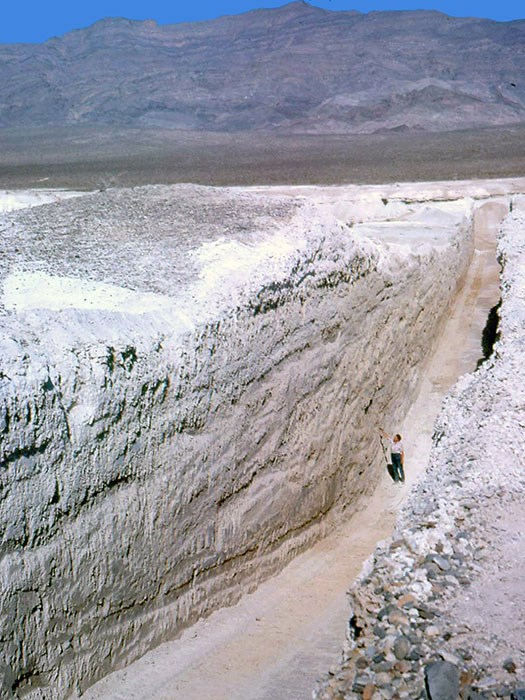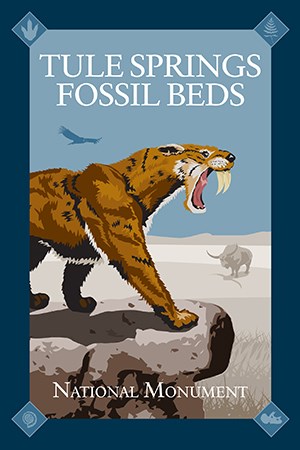Part of a series of articles titled Park Paleontology News - Vol. 11, No. 1, Spring 2019.
Article
Tule Springs Fossil Beds National Monument – a Pleistocene treasure trove

Article by Kathleen B. Springer and Jeffrey S. Pigati, U.S. Geological Survey

Photo by Eric Scott
Tule Springs Fossil Beds National Monument (TUSK) is located in the Las Vegas Valley of southern Nevada and was established by Congress on December 19, 2014 as the 405th unit of the National Park Service [FIGURE 1]. Well before its designation as a park unit, the area known as Tule Springs played a vital role in shaping the history of archaeology and paleontology of the region. In fact, vertebrate fossils have been known from the area for more than a century, beginning in 1903 when Josiah Spurr of the U.S. Geological Survey reported teeth and bones in the sediments exposed in the upper Las Vegas Wash between Corn Creek Springs and Tule Springs. Several paleontologic and archaeologic investigations followed, which led to intense interest by the archaeologic community to investigate whether Tule Springs preserved evidence about the early peopling of North America.

San Bernardino County Museum archives, Eric Scott restored
This interest culminated in the extensive and multidisciplinary Tule Springs Expedition of 1962–63, which sought to determine if humans and Pleistocene megafauna coexisted . In what came to be known as the Big Dig, the expedition combined traditional field techniques with massive earth-moving activities. Heavy construction equipment carved enormous trenches into the sediments at Tule Springs to expose vertical walls that allowed the sediments to be studied in detail [FIGURE 2]. Geologist C. Vance Haynes, Jr., directed the geological investigations and subdivided the fossil-rich sediments into distinct units of the Las Vegas Formation. He also assigned ages to the units using the newly developed radiocarbon dating technique, which had never been used on such a grand scale. Haynes’ targeted approach demonstrated that human-made artifacts only occurred in the youngest levels of the formation—those layers lacking the fossilized remains of Pleistocene animals. Consequently, the hypothesis that early humans coexisted with Pleistocene megafauna at Tule Springs was disproven, and interest in the site faded.
A long intermission in scientific research followed, lasting until the 2000s when scientists Kathleen Springer, Eric Scott and their team from the San Bernardino County Museum conducted comprehensive and systematic paleontological excavations of the area. In all, they discovered nearly 600 new fossil localities and collected and curated more than 40,000 vertebrate fossils. They also established the vertebrate fossil assemblage found in Tule Springs Fossil Beds National Monument as the Tule Springs local fauna, which represents one of the most significant late Pleistocene vertebrate faunas in the American Southwest. The fauna occurs throughout most of the Las Vegas Formation and spans from approximately 100,000 to 12,500 years ago. The Tule Springs local fauna is both abundant and diverse and includes numerous species of large mammals, as well as smaller vertebrates such as frogs, lizards, snakes, birds, and rodents. Invertebrates such as aquatic and terrestrial snails, tiny clams, and ostracodes are also common.

Although the evocative saber-tooth cat is the logo of TUSK [FIGURE 3], the Columbian mammoth (Mammuthus columbi) is truly the iconic animal known from the fossil beds [FIGURES 4,5]. Mammoth remains have been discovered throughout the monument and dominate the Tule Springs local fauna in terms of sheer numbers of fossils. Yesterday’s camel (Camelops hesternus) was widespread in western North America during the late Pleistocene and is the second most common animal found at Tule Springs. Two species of bison were present in the valley, including a long-horned species (Bison latifrons?) and a smaller species (Bison antiquus). Three types of horses also lived there during the late Pleistocene: a large stout-legged horse (Equus scotti), a small stout-legged horse (Equus sp.), and a small stilt-legged species (Haringtonhippus francisci). Sloths included Jefferson’s ground sloth (Megalonyx jeffersonii) and Shasta ground sloth (Nothrotheriops shastensis). In addition, rare fossils of American lion (Panthera atrox), and new findings of dire wolf (Canis dirus) and saber-toothed cat (Smilodon fatalis), show that carnivores prowled the valley during the late Pleistocene.

Photo by Eric Scott
Tule Springs Fossil Beds National Monument preserves nearly 23,000 acres of the Las Vegas Formation, which provides the geologic context of the fossils. The formation’s silty, light-colored sediments were once thought to be the remnants of a large Pleistocene lake, but it is now known that they actually represent a vast spring ecosystem that existed periodically for millennia, occupying nearly the entire valley at times. During the Pleistocene, the climate was wetter than today, and the water table was so high that groundwater flowed up to the ground surface as springs. Specific environments, such as marshes and wet meadows, spring pools and ponds, and spring-fed streams, can be recognized through careful examination of the resulting groundwater discharge deposits. Recently, Kathleen Springer and Jeff Pigati of the U.S. Geological Survey expanded the stratigraphy and chronology of the Las Vegas Formation, and subdivided the sequence into 17 different geologic units that collectively span more than 500,000 years (vertebrate fossils are known from 13 of these units). They also documented that this spring-derived sedimentary sequence exhibited numerous breaks in the record when no wetland development occurred. Stable surfaces (soils) and erosional events marked these periods of megadrought when the springs dried up completely. Importantly, they were able to link the pattern of wetting and drying in the Las Vegas Valley to abrupt warming events recorded in the Greenland ice core record, and concluded that these desert springs and wetlands responded dynamically to abrupt changes in climate throughout the late Quaternary, in temporal sync with northern hemispheric climatic oscillations. The realization that the spring ecosystems responded rapidly to changing climate in the past offers a new and unique opportunity to study the Tule Springs local fauna, one of the best documented late Pleistocene faunal sequences anywhere in North America, and analyze the faunal dynamics through time, up to and including the Pleistocene extinction event [FIGURE 6].

Photo by Eric Scott
The eroded badland landscape of TUSK, so near to the hustle and bustle of a well-known urban metropolis, is a national park unit with unlimited scientific research potential. Geologic, paleontologic and climate change studies, as well as resource management, protection and interpretation continue today at Tule Springs Fossil Beds National Monument through the efforts of scientists from the U.S. Geological Survey, National Park Service, and academic institutions across the country.

Photo by Eric Scott
For more information:
Springer, K.B., Pigati, J.S., Manker, C.R., Mahan, S.A., 2018, The Las Vegas Formation. U.S. Geological Survey Professional Paper 1839, 62 p. https://doi.org/10.3133/pp1839
Springer, K.B., Pigati, J.S., Scott, E., 2018, The geology and paleontology of Tule Springs Fossil Beds National Monument. U.S. Geological Survey Fact Sheet 2018-3038, 4 p. https://doi.org/10.3133/fs20183038.
Scott, E., Springer, K.B., Sagebiel, J.C., 2017, The Tule Springs local fauna: Rancholabrean vertebrates from the Las Vegas Formation, Nevada. Quaternary International 443A, 105-121. https://doi.org/10.1016/j.quaint.2017.06.001
Scott, E., Springer, K.B., 2016, First records of Canis dirus and Smilodon fatalis from the late Pleistocene Tule Springs Local Fauna, southern Nevada. PeerJ 4:e2151 https://doi.org/10.7717/peerj.2151
Pigati, J.S., Springer, K.B., Manker, C.R., 2015, Desert wetlands – archives of a wetter past. U.S. Geological Survey Fact Sheet #2015-3077. https://doi.org/10.3133/fs20153077
Springer, K.B., Manker, C.R., Pigati, J.S., 2015, Dynamic response of desert wetlands to abrupt climate change. Proceedings of the National Academy of Sciences USA 112 (47), 14522-14526. https://doi.org/10.1073/pnas.1513352112
Last updated: April 23, 2020
